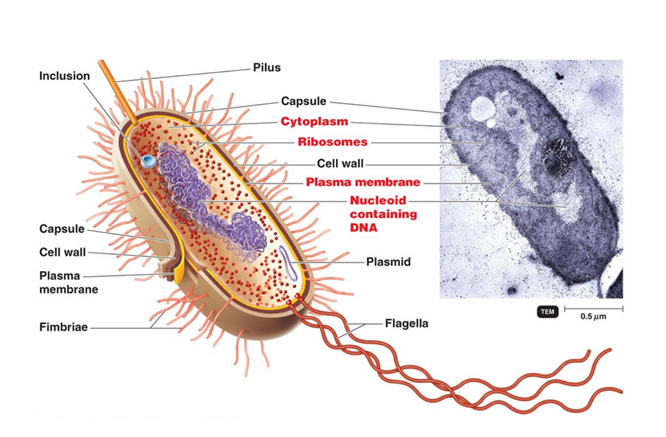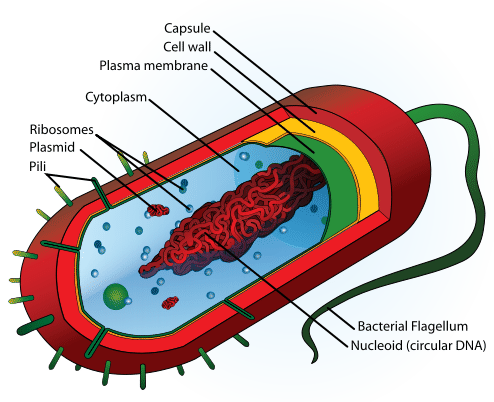The major components of LPS molecules are core polysaccharide bound to lipid A and long external 0 polysaccharide side chain. Drawing of a typical bacterial cell by Vaike Haas University of Wisconsin-Madison Primary Structure of Biological Macromolecules Determines Function Procaryotic structural components consist of macromolecules such as DNA RNA proteins polysaccharides phospholipids or some combination thereof.
Cell wall Rigid barrier that surrounds the cell keeping the contents from bursting out.

. The saccharide component of the cell wall has alternating repeating units of two amino sugars related to glucose. The basis for the Gram stain lies in fundamental structural differences in the cell envelope of these two groups of bacteria. They facilitate the joining of amino acids.
Diplococci s diplococcus pairs streptococci chains staphylococci grape-like clusters tetrads 4 cocci in a square sarcinae cubic configuration of 8 cocci 7 Shape and Arrangement-2 bacilli s bacillus rods coccobacilli very short rods. D How does penicillin disrupt bacterial cell walls. The cell wall is composed of peptidoglycan that provides structure to the cell wall.
Bacteria is released only after cell lysis. The bacteria diagram given below represents the structure of bacteria with its different parts. What are some typical bacterial cell membrane components.
In Gram-positive bacteria peptidoglycan makes up as much as 90 of the thick cell wall enclosing the plasma membrane. Thus a bacterial cell wall is glycopeptide which is also known as peptidoglycan. The basic components of bacterial cells are- Cell wall Plasma membrane Cytoplasm Chromosome Ribosome.
The cell envelope encases the cytoplasm and all its components. 1 the O-antigen or O-polysaccharide which represents the outermost part of the structure 2 the core polysaccharide and 3 lipid A which anchors the LPS into the outer membrane. Bacterial cells consist of a phospholipid bilayer and in some cases a layer of peptidoglycan.
For our discussion of the Gram-negative bacterial cell envelope we will use Escherichia coli an extensively-studied organism that has served as a model for understanding a number of fundamental biological processes. The bundle is held together by a cap and may or may not be encapsulated. Cell wall is composed of two polymers one consisting of saccharide subunits and the other consisting of amino acid subunits.
They have the ability to form tough dormant structures known as endospores that helps them to survive under unfavourable conditions. Bacterial CellCommunity Structure 1. Bacterial cell Structure and Function 1.
Bacteria Diagram representing the Structure of Bacteria. Capsule is 98 water and 2. Ribosomes Structures involved in protein synthesis.
LPS is made up of three different components. The phospholipid bilayer either allows or denies ions and other molecules entry to the cell based on factors such as size and charge. Describe how bacteria find areas of higher nutrient concentration or less repellant.
1 flagellum 2 pili 3 capsule 4 cell envelope What role do flagella pili and capsules play in bacterial virulence. A whip-like filament a motor complex and a hook that connects them. The filament is approximately 20 nm in diameter and consists of several protofilaments each made up of thousands of flagellin subunits.
It is a gel-like matrix composed of water enzymes nutrients wastes and gases and contains cell structures such as ribosomes a chromosome and plasmids. Capsule is 02µm thick viscus layer outer layer to the cell wall. Unlike the eukaryotic true cells bacteria do not have a membrane enclosed nucleus.
It is 15-20 nm hair like helical structure emerges from cell wall. The cell wall plasmid cytoplasm and flagella are clearly marked in the diagram. Peptidoglycan provides the rigidity for the cell wall.
They also possess extrachromosomal DNA known as plasmids. The bacterial flagellum consists of three basic components. Discuss the phenomena of how bacteria find nutrients.
3 1 capsules - adherenceattachment 2 flagella - getting away from immune system 3 pili - attachment to surfaces What are the three parts of bacterial taxonomy. Plasma membrane cytoplasmic membrane. C How do components of human tears disrupt bacterial cell walls.
Bacteria have some unique structures such as pili flagella and capsule. Describe the fundamental components of the bacterial motility apparatus where its parts are located relative to the cell and the order and manner in which its parts are synthesized. The polysaccharide side chains of the LPS molecules stimulate antibody production and correspond to.
B What are the differences between gram positive and gram negative cells walls. During Gram staining these thick multiple layers 2080 nm of peptidoglycan retain the dark purple primary stain crystal violet whereas Gram-negative bacteria stain pink. A Describe the structure of peptidoglycan that is found in all bacterial cell walls.
We have already covered the main internal components found in all bacteria namely cytoplasm the nucleoid and ribosomes.

Bacteria Cell Evolution Classification Britannica



0 Comments